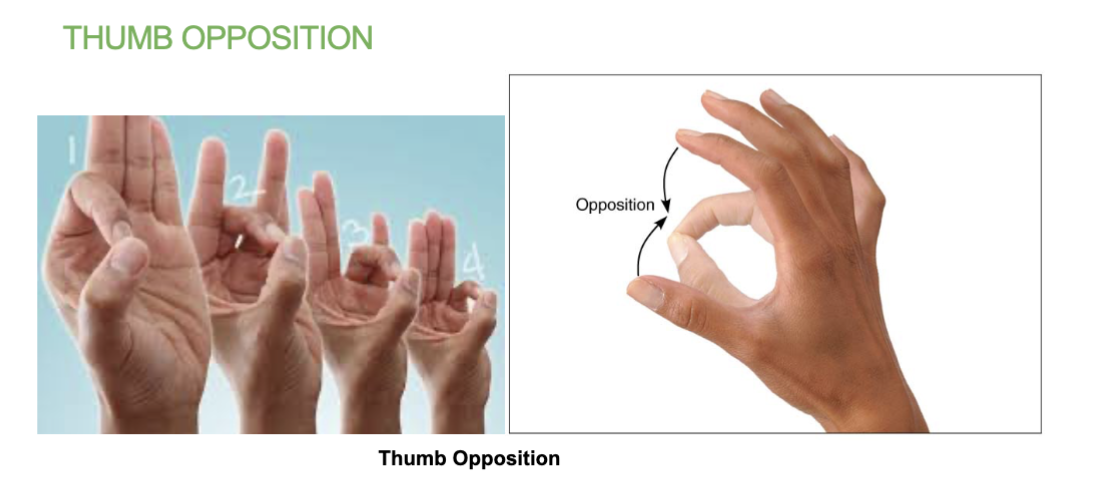6. joints
1/57
There's no tags or description
Looks like no tags are added yet.
Name | Mastery | Learn | Test | Matching | Spaced |
|---|
No study sessions yet.
58 Terms
What are joints/articulation?
A joint or articulation is the place where two or more bones come together.
Job of the joints?
to hold the skeleton together and allow mobility.
3 classifications of joints
( the 3 diff structures and movement abilities )
fibrous (Synarthrosis- immovable), cartilaginous (Amphiarthrosis- slightly movable) and synovial (Diarthrosis - freely movable)
Fibrous joints functions
Synarthrosis (immovable)
Does NOT allow movement
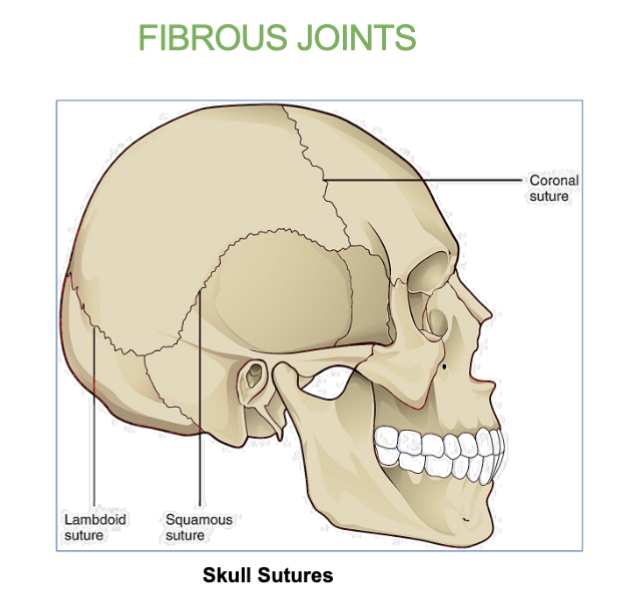
Example of a fibrous joint
Skull
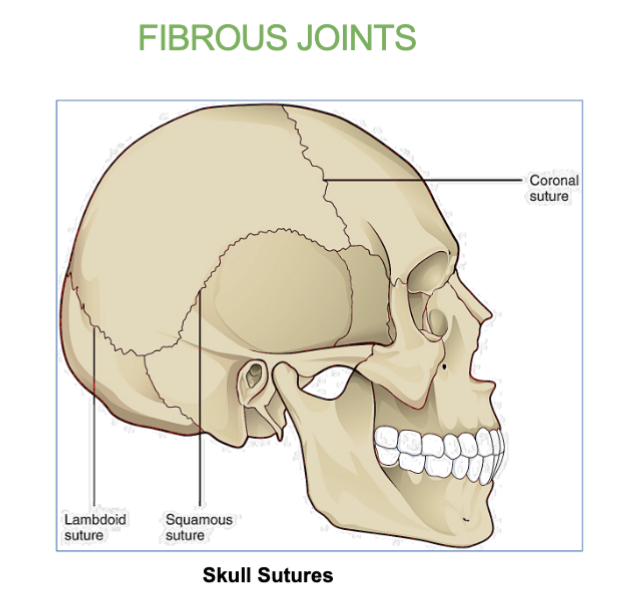
Cartilaginous joints functions
Amphiarthrosis (slightly movable)
allos for SOME movement, very little
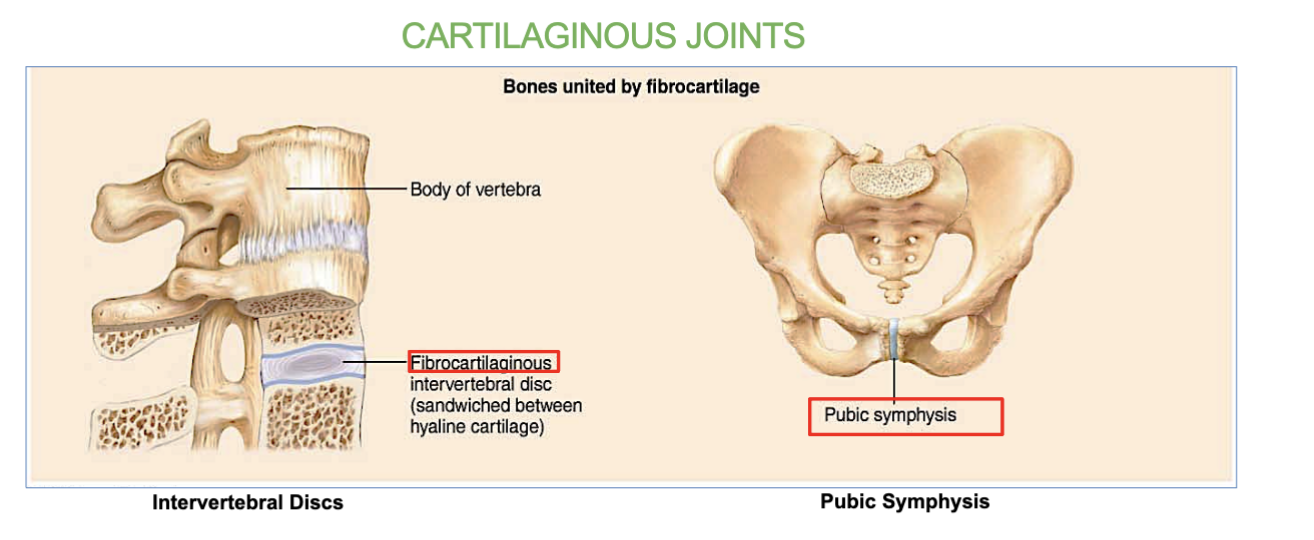
2 Examples of a cartilaginous joint
intervertebral discs (between the vertebrae in the spine)
Symphysis pubis (joint located between the left and right pubic bones at the front of the pelvis)
allows for limited movement
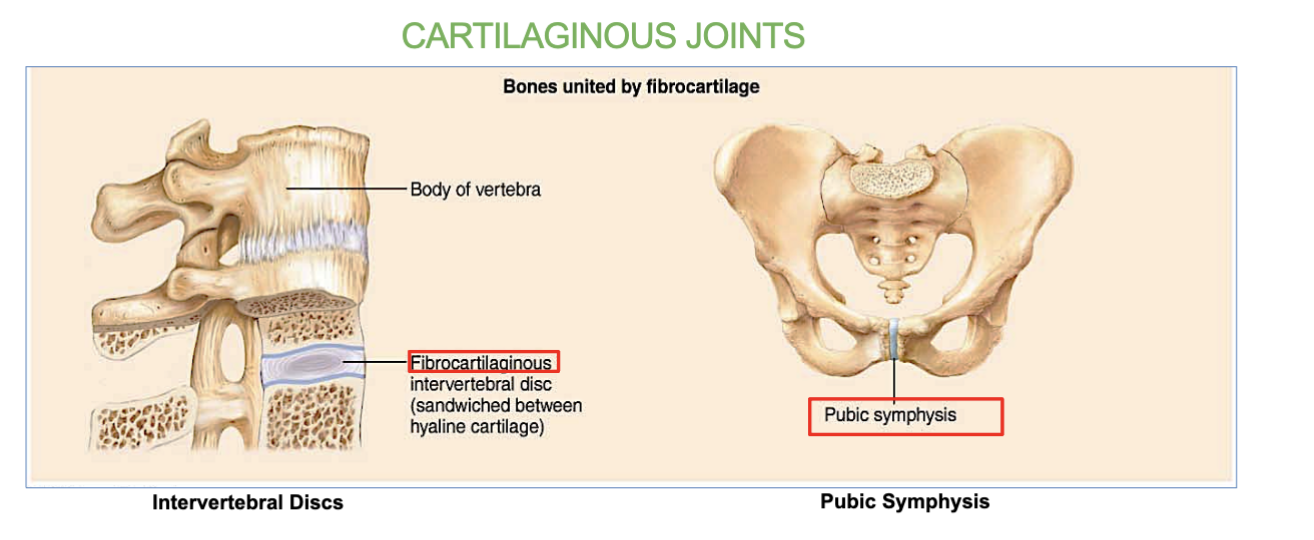
2 Examples of synovial joints
the shoulder and hips
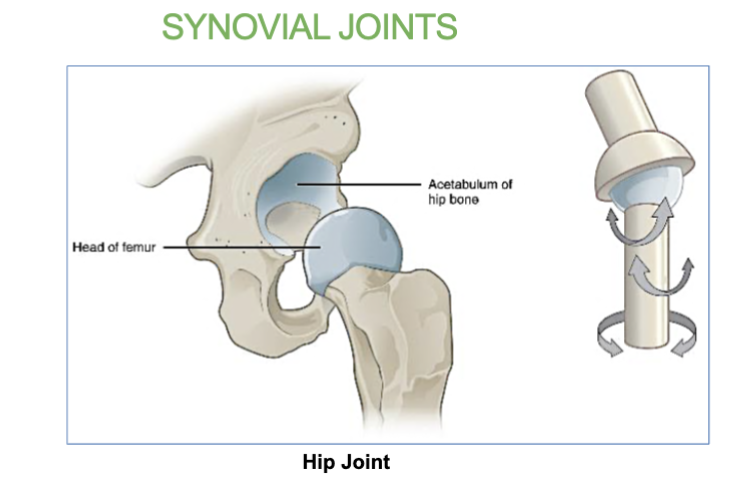
4 Structures of a synovial joint
Articular cartilage - end of long bones. covered in thin layer of hyaline cartilage
Synovial (joint Cavity) - filled with synovial fluid.
(synovial membrane secretes synovial fluid)
Reinforcing ligaments - Ligaments that support the joints by holding bone to bone and resisting excess or abnormal joint movements
Articular Capsule- what surrounds the joint.
contains the synovial joint cavity/membrane, and the reinforcing ligament (not the articular cartilage)
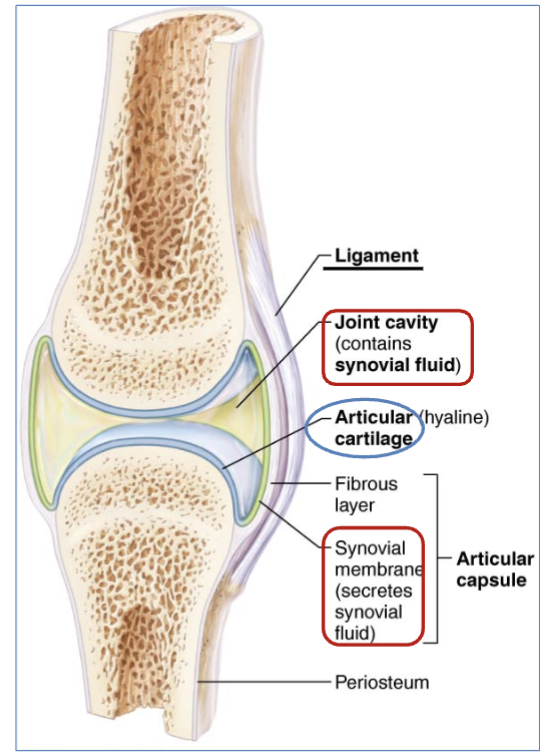
definition of Articular cartilage
(structure in synovial joint movement)
end of long bones, covered in thin layer of hyaline cartilage.
(reduces friction and allows for smooth movement of the joint)
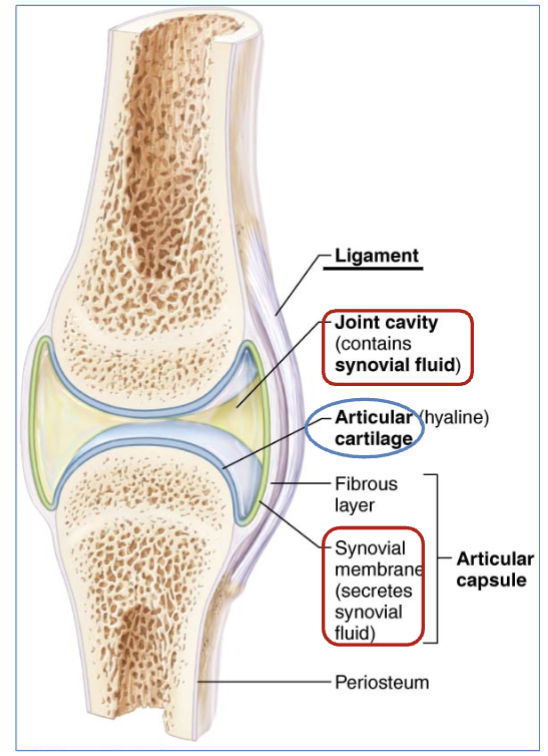
definition of Synovial (joint) cavity
(structure of the synovial joint)
cavity filled with synovial fluid.
(synovial membrane secretes synovial fluid)
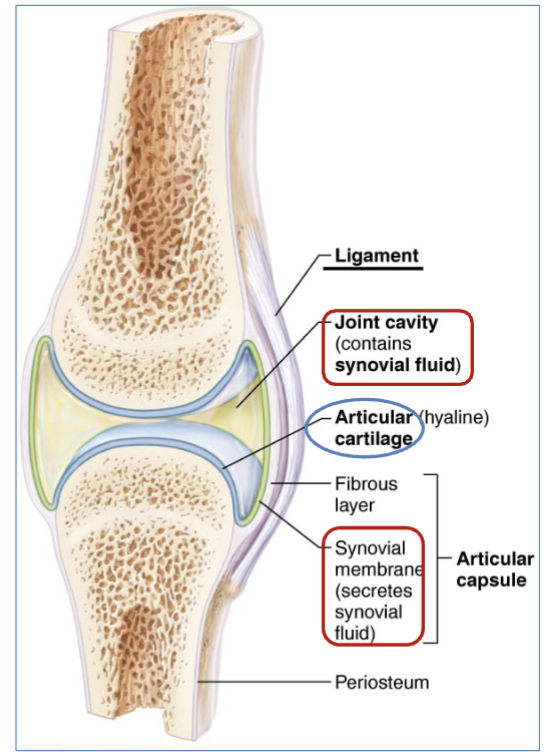
What secretes synovial fluid?
the synovial membrane
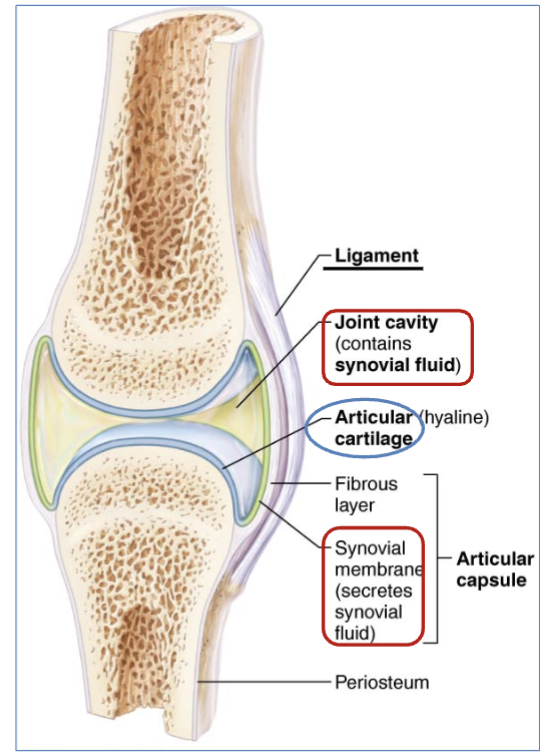
definition of Articular capsule
(structure in synovial joint movement)
double layered structure that surrounds the joint.
contains the synovial joint cavity/membrane, and the reinforcing ligament (not the articular cartilage)
provides stability and flexibility
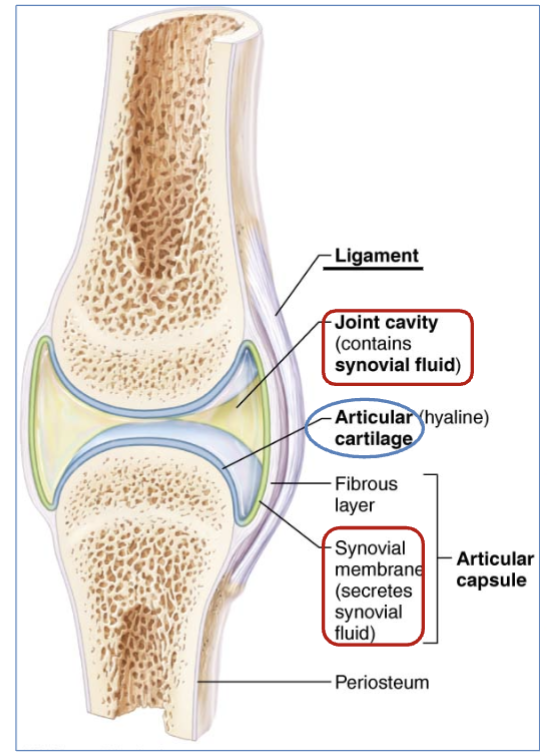
definition of Reinforcing ligaments
(structure in synovial joint movement)
are Ligaments that support the joints by holding bone to bone and resisting excess or abnormal joint movements.
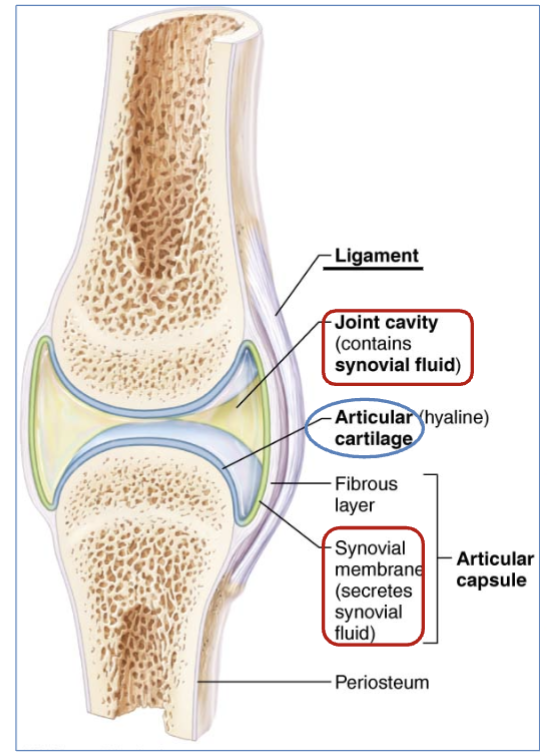
3 factors that can influence joint stability
Articular surfaces - Joints with deeper sockets, like the hip, are more stable because they securely hold the bone in place.
Ligaments- More ligaments provide more stability.
Muscle tone- Strong muscle tone makes joint more stable
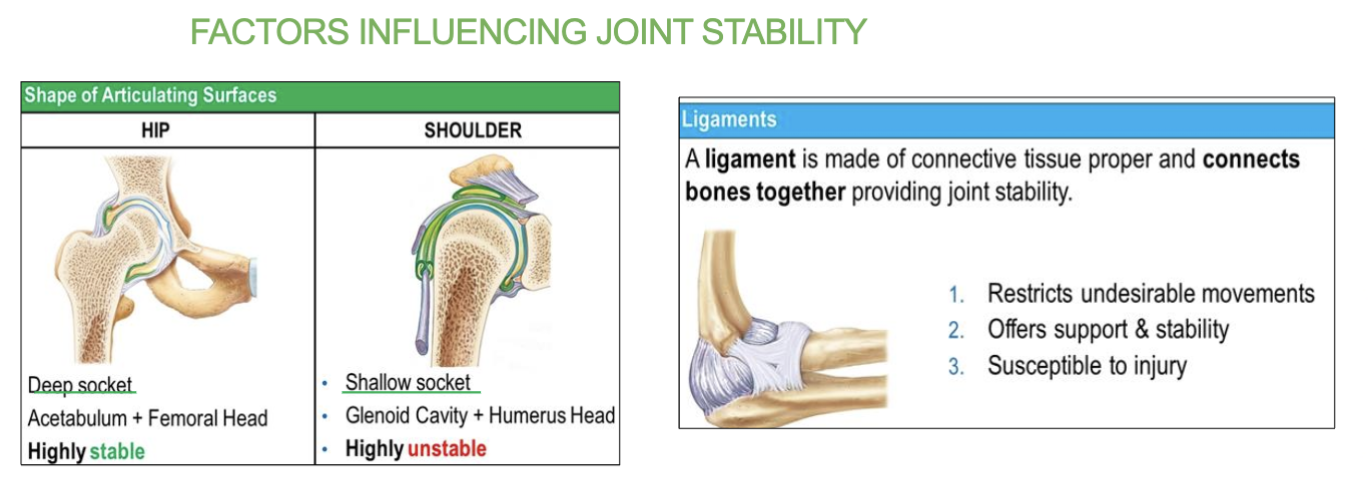
Whats a ligament and where are they?
a tough, fibrous connective tissue that connects bones to other bones at a joint, providing stability.
on the outside of bones
3 jobs of the ligament
restricts undesirable movements
offers support & stability
but IS susceptible to injury
2 shapes/examples of articulating surfaces (2 sockets)
Deep socket and Shallow socket
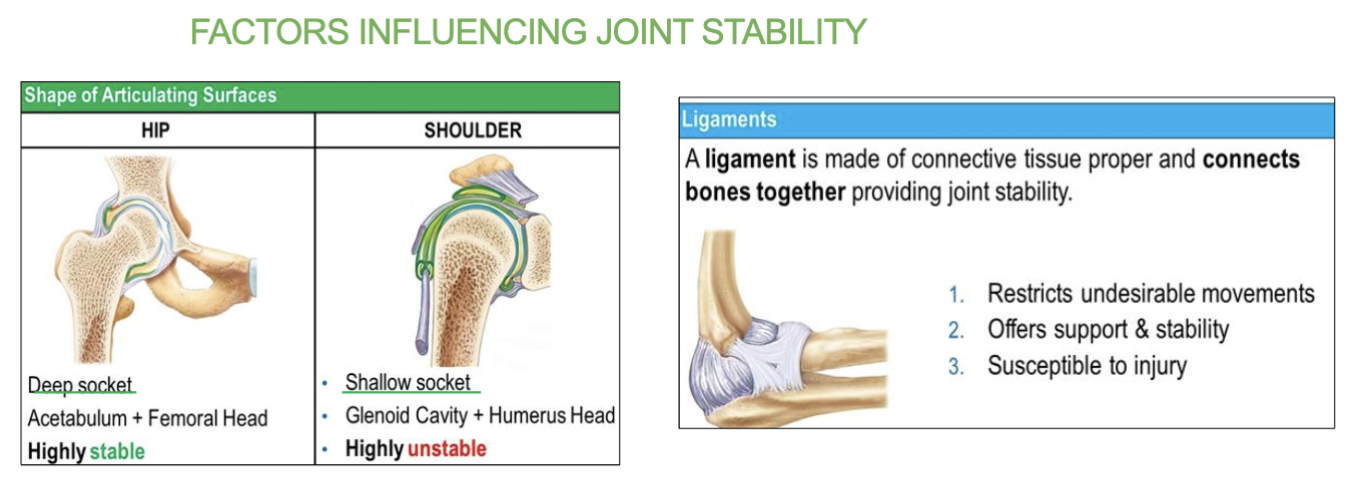
what does “articulating surfaces” mean?
& two examples?
where bones come into contact and interact with each other at a joint.
These surfaces are often covered with hyaline cartilage
EX- deep + shallow sockets
Job of deep socket
Provides more stability and less mobility.
(ex- hip joint (acetabulum)a + femoral head)
Highly stable
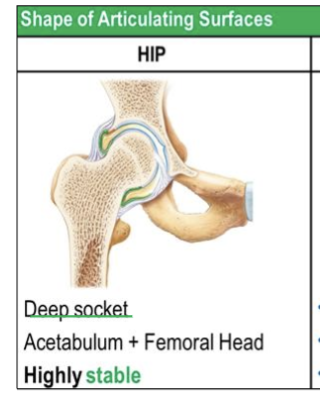
job of shallow socket
Allows greater mobility but less stability.
(ex- shoulder joint (glenoid cavity), + humeral head)
highly unstable
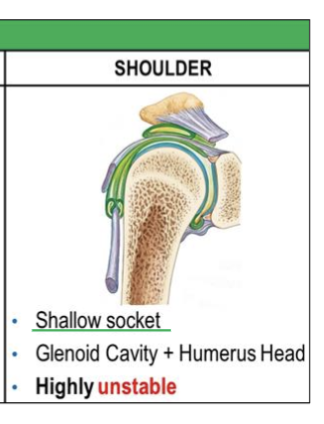
3 Friction reducing structures within joints
bursa
tendon sheath
meniscus
What’s the Bursa definition/job
a friction reducing structure within joints
its Sac filled with synovial fluid that prevents friction between muscle, or tendon and underlying bone.
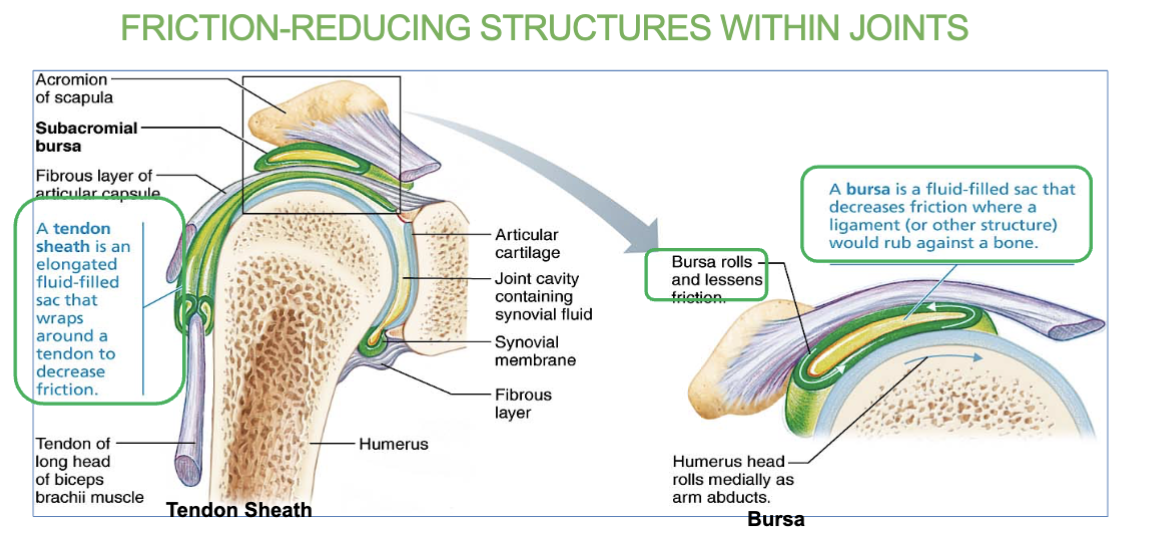
What’s a bursa?
Sac filled with synovial fluid that prevents friction between muscle, or tendon and underlying bone.
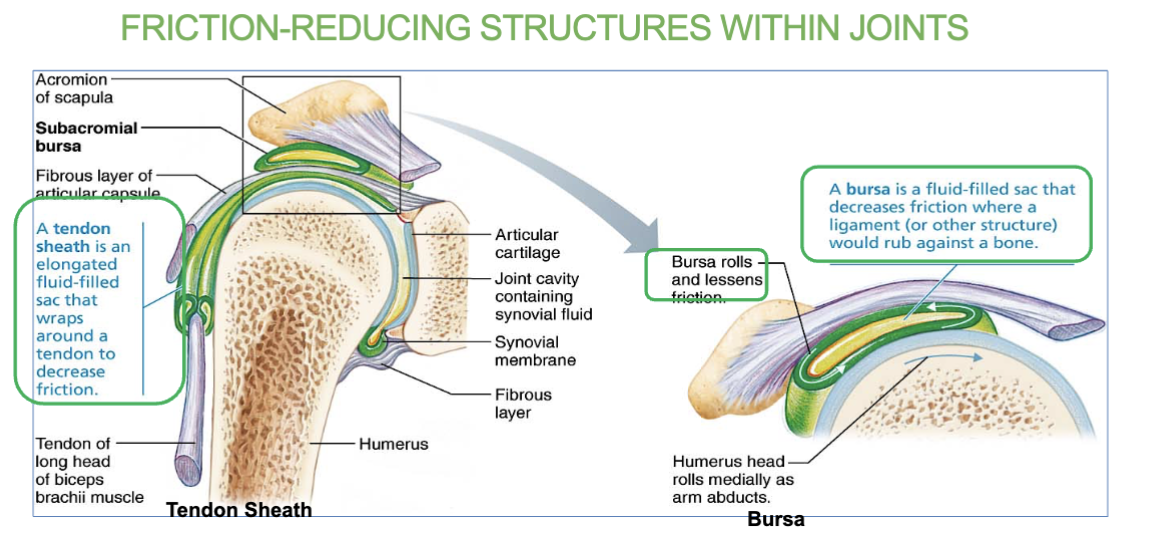
Tendon sheath definition/job
(a friction reducing structure within joints)
An elongated bursa that wraps around tendon.
decreases friction.
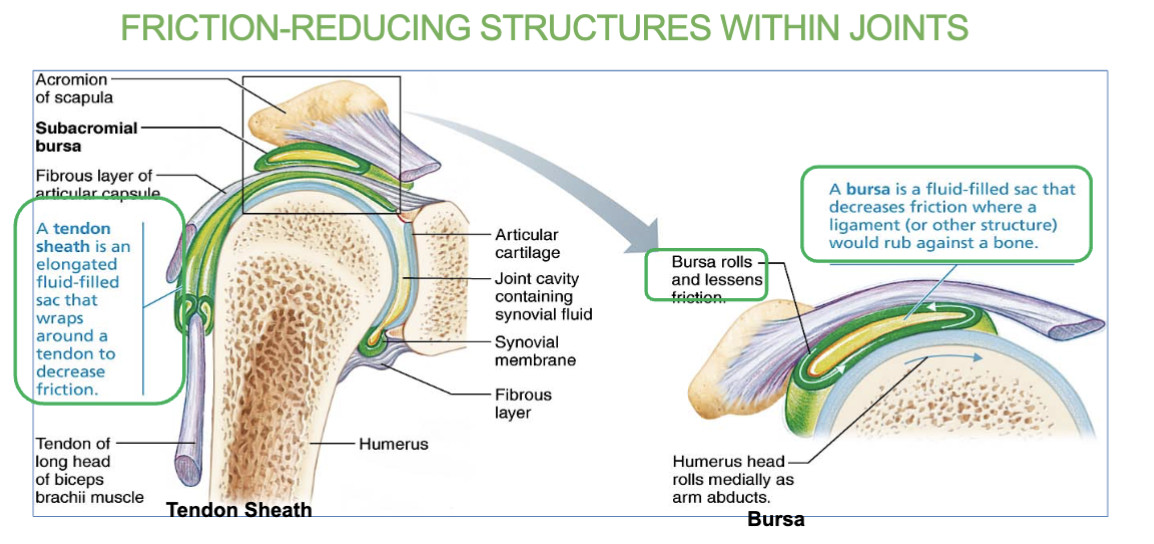
What’s the Meniscus definition/job
a friction reducing structure within joints
its a C shaped cartilage between two bones.
two types - lateral and medial meniscus

the 2 types of “meniscus” and where can you find them?
lateral and medial meniscus
in the knee joint
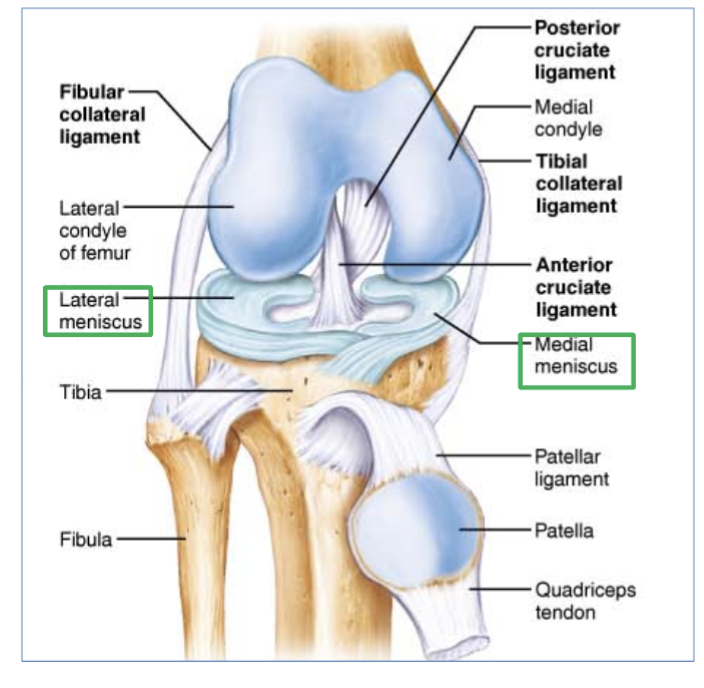
3 structures of the knee joint
Tibial & Fibular collateral ligaments
Anterior & posterior cruciate ligaments
Medial & lateral menisci (2 c shaped cartilages within the knee)
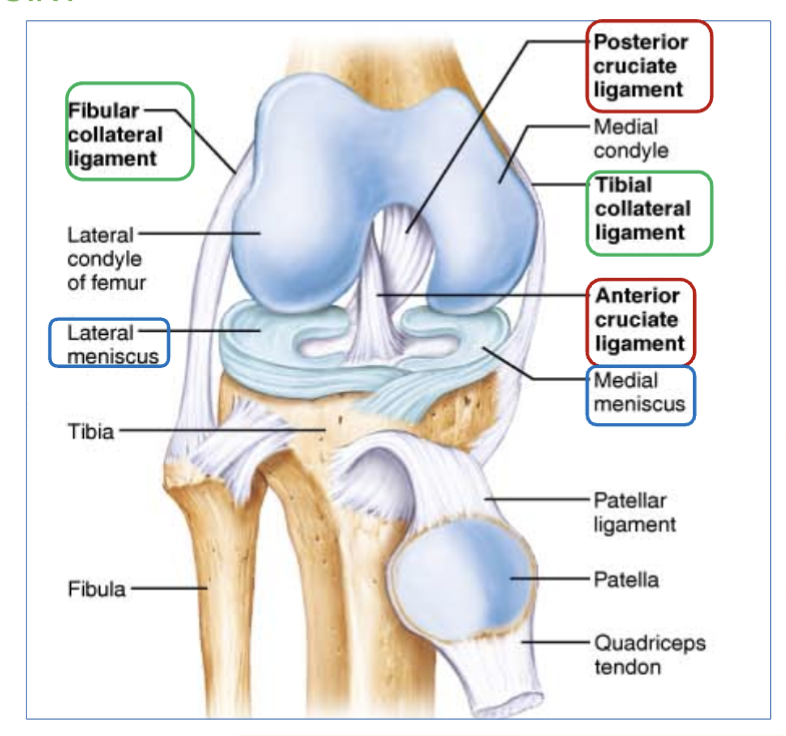
Tibial & Fibular collateral ligaments location
located on both (left & right) sides of the knee outside of the articular capsule
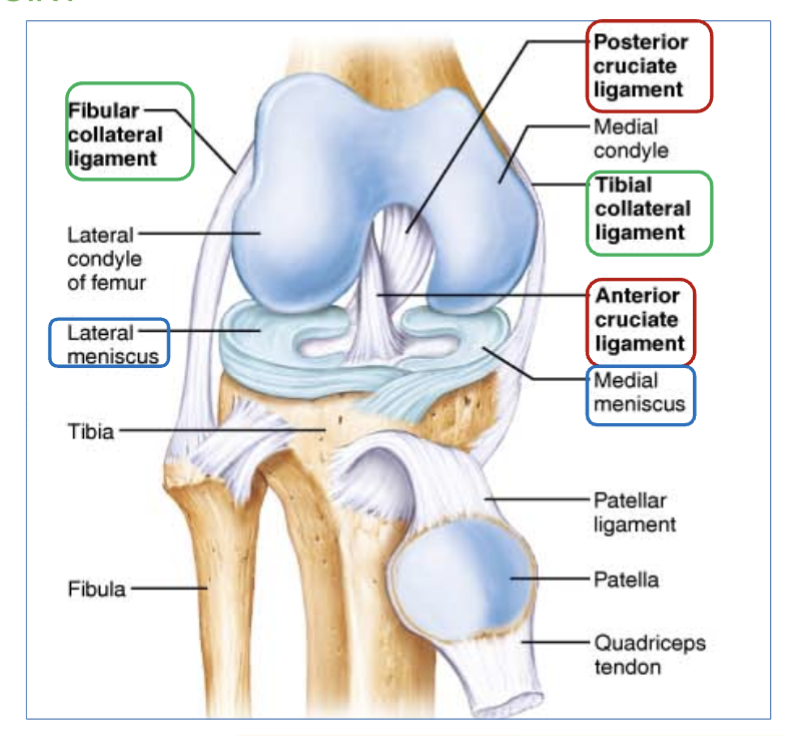
Anterior & posterior cruciate ligaments location
found inside the capsule, in the front and back of knee.
(ex- ACL, most common injury of ligament in knee, takes long time to heal)
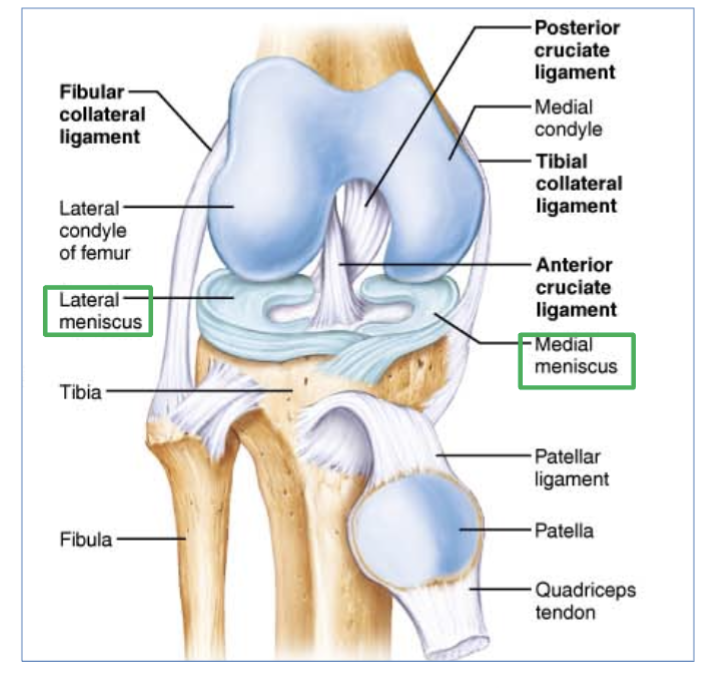
Medial & lateral menisci
job & location
C shaped cartilages - provide padding,support and help reduce friction between the femoral condyles and tibial condyles.
-
(right and left side of knee, inside articular cartilage)
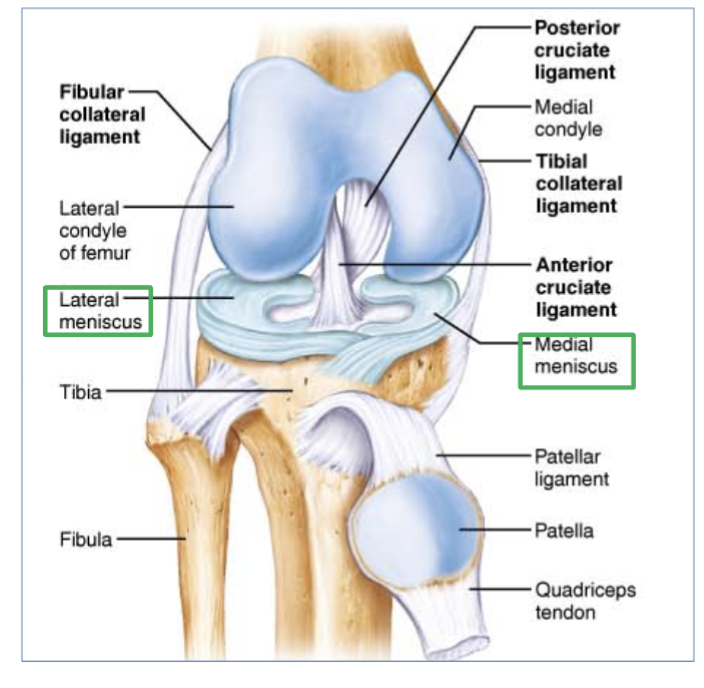
Most common ligament in the knee that is torn?
the AnterioR cruciate ligament ( ACL )
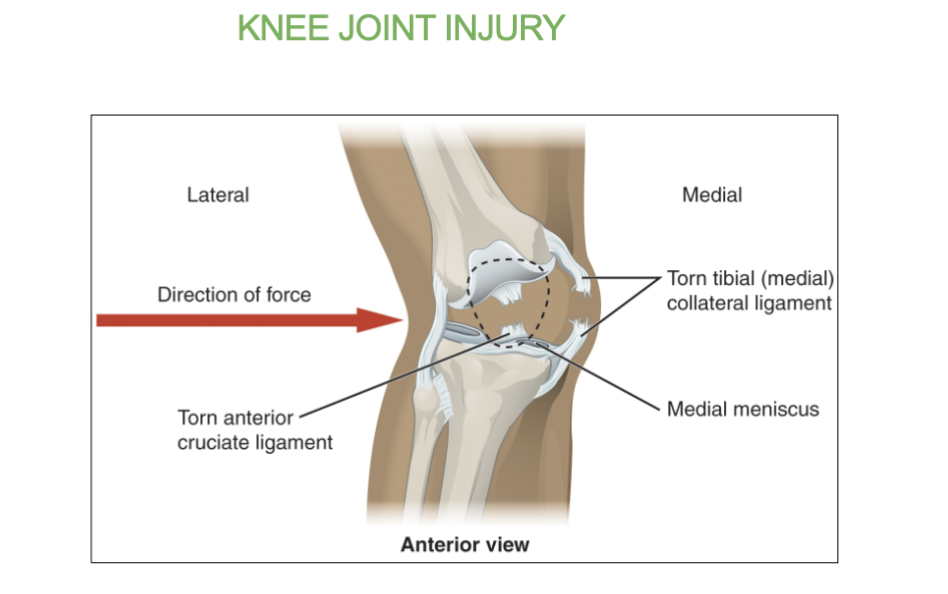
which joint is the largest joint of the body?
the knee joint
4 types of synovial joints?
pivot joints (doesn’t move, allows for rotation around its axis)
hinge joints ( ex - door hinge, angular movement)
planar joints (gliding movement ← →)
ball and socket (360 movement)
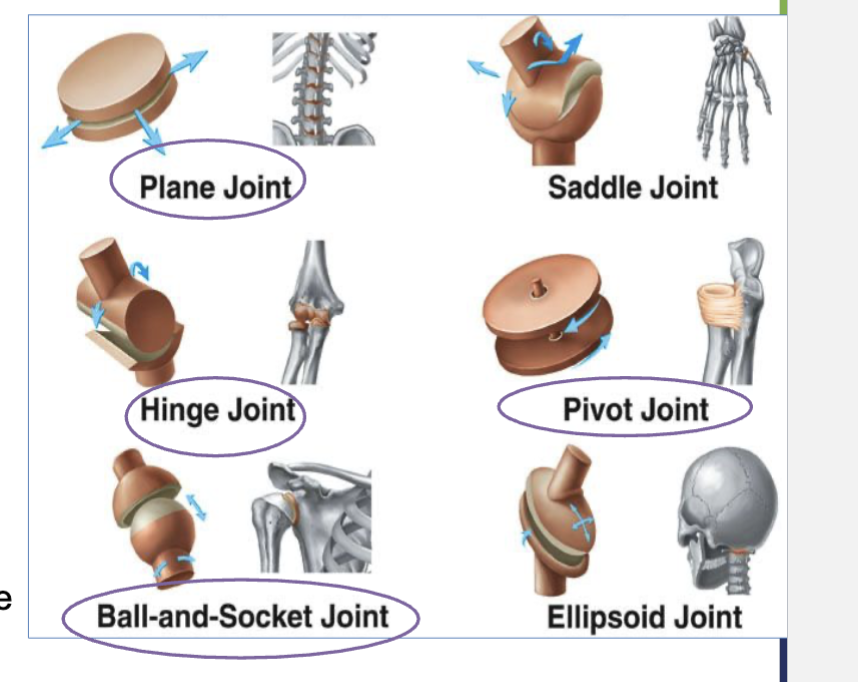
Pivot joints job/definition & 2 examples
let bones rotate around a central point (axis).
2 examples (remember) -
the atlantoaxial joint is where the C1 vertebra (atlas) and C2 vertebra (axis) meet. This joint lets your head rotate side-to-side (like shaking your head "no").
The radius (forearm bone) rotates around the ulna (another forearm bone), allowing your wrist and forearm to rotate
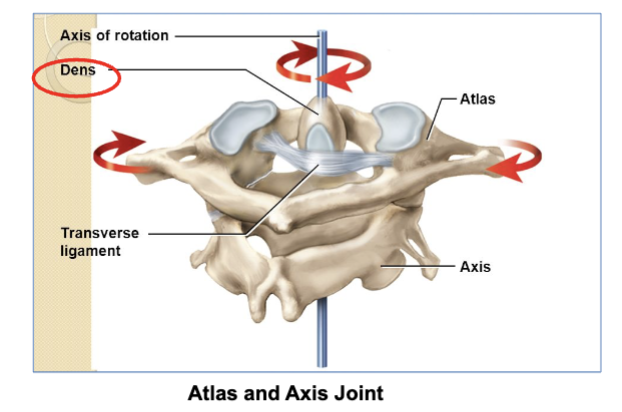
2 examples of pivot joints?
the atlantoaxial joint.
( where the C1 vertebra (atlas) and C2 vertebra (axis) meet. This joint lets your head rotate side-to-side - the atlas rotates )
- the Radius & Ulna .( The radius (forearm bone) rotates around the ulna (another forearm bone ) allowing your wrist and forearm to rotate )
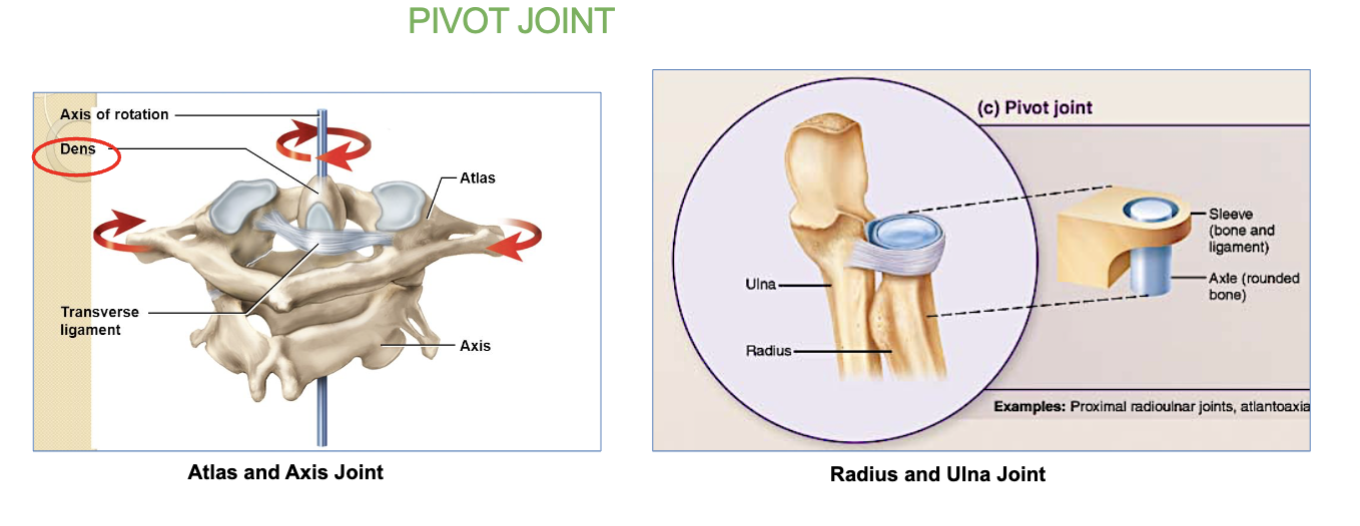
whats the atlantoaxial joint? (and its job)
a pivot joint.
its where the C1 vertebra (atlas) and C2 vertebra (axis) meet.(the atlas rotates)
This joint lets your head rotate side-to-side (like shaking your head "no").
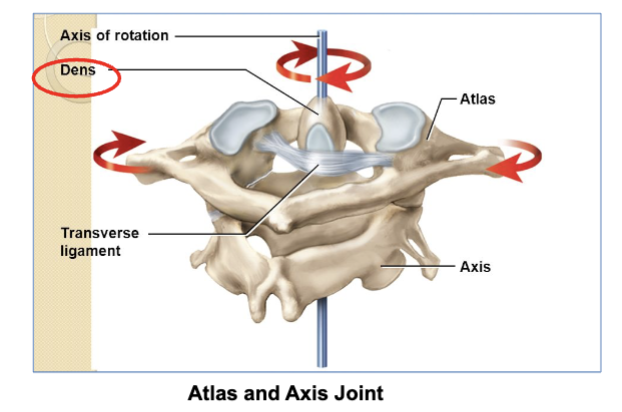
Name of the c1 vertebra for atlantoaxial joint?
& is this the one that rotates?
Atlas
yes this is the that one rotates.
Name of the c2 vertebra for atlantoaxial joint?
& is this the one that rotates?
axis
no, the one that rotates is c1 (atlas)
“The radius (forearm bone) rotates around the ulna (another forearm bone), allowing your wrist and forearm to rotate”
which joint is this an example of?
pivot joints
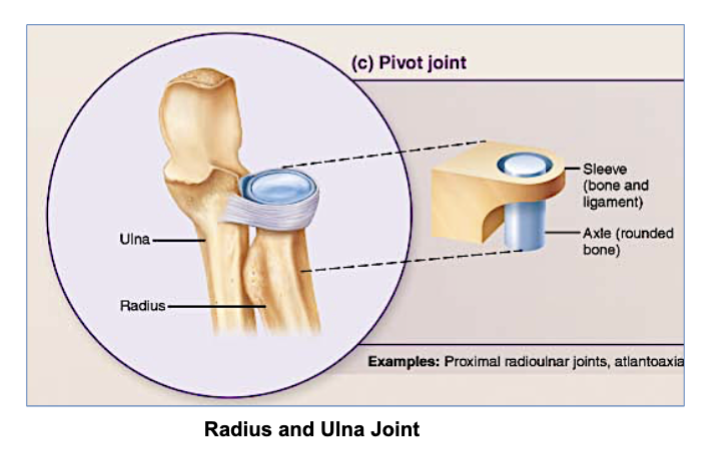
Hinge joint definition/job
& 2 examples
a type of synovial joint (Diarthrosis-freely movable)
-
works like a door hinge, allows flexion and extensions.
EX- elbow & knee
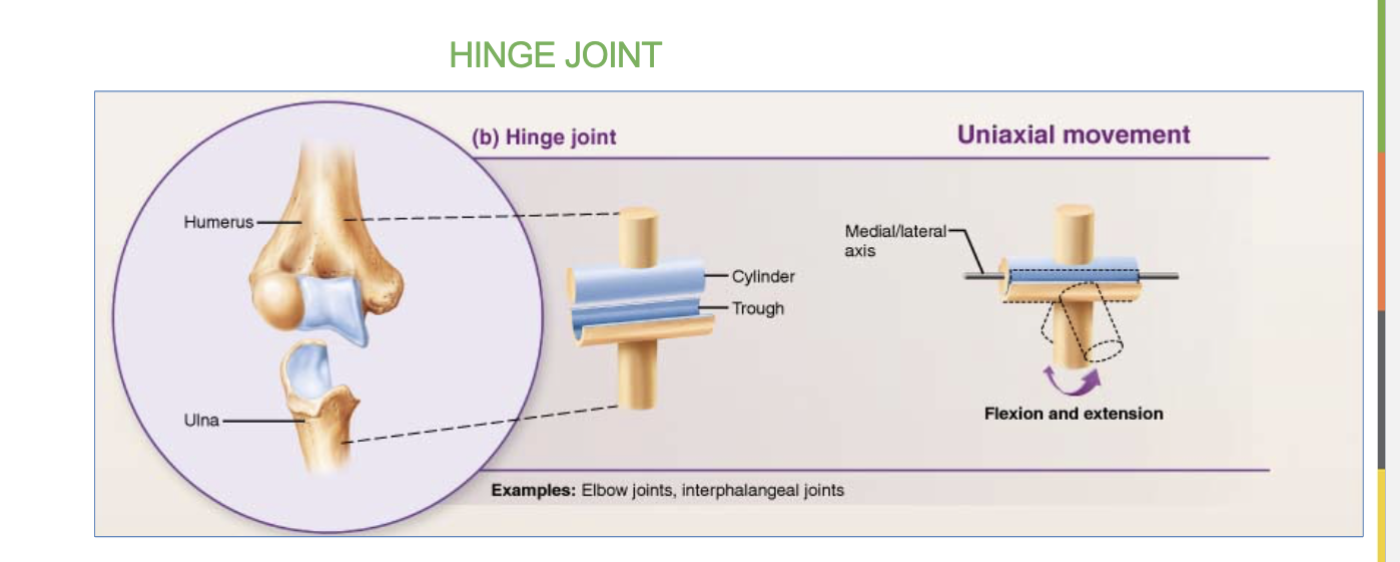
which joint allows for flexion and extensions?
the hinge joint.
Which joint allows for bones to rotate around a central point (axis)?
pivot joints
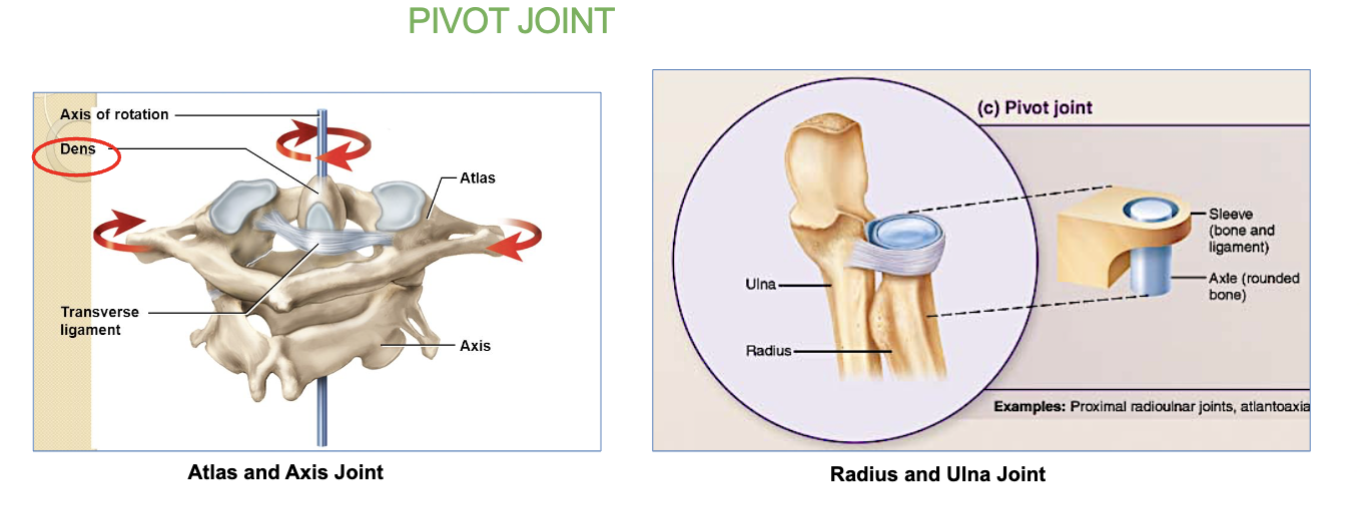
Planar joint definition/job
& 2 examples
allow for limited gliding movements ← →
ex- carpal bones (wrist) and tarsal bone (ankles)
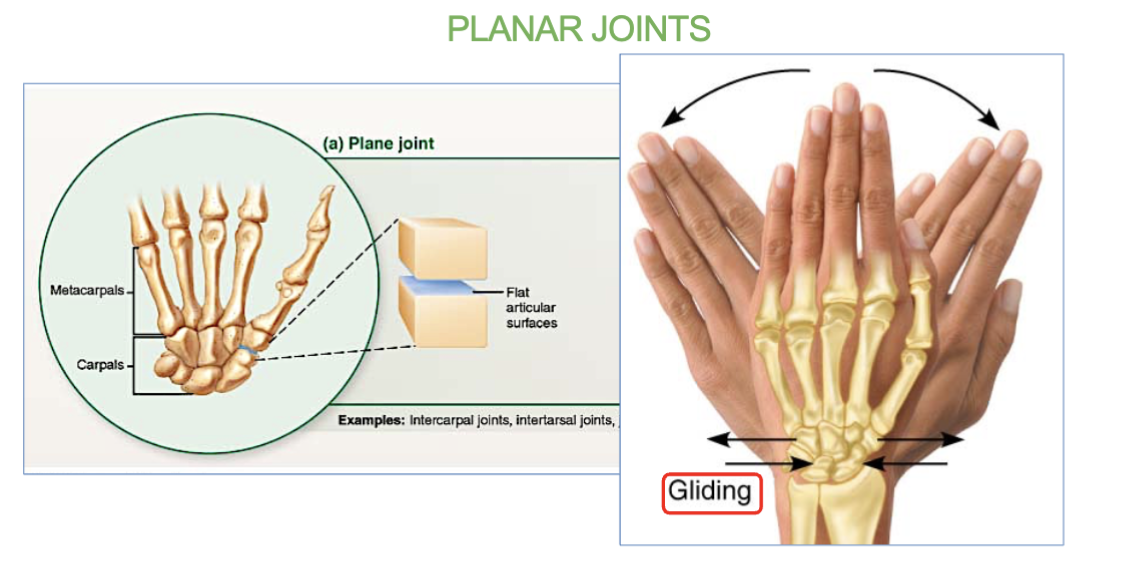
which joints allows for limited gliding movement?
Planar joints
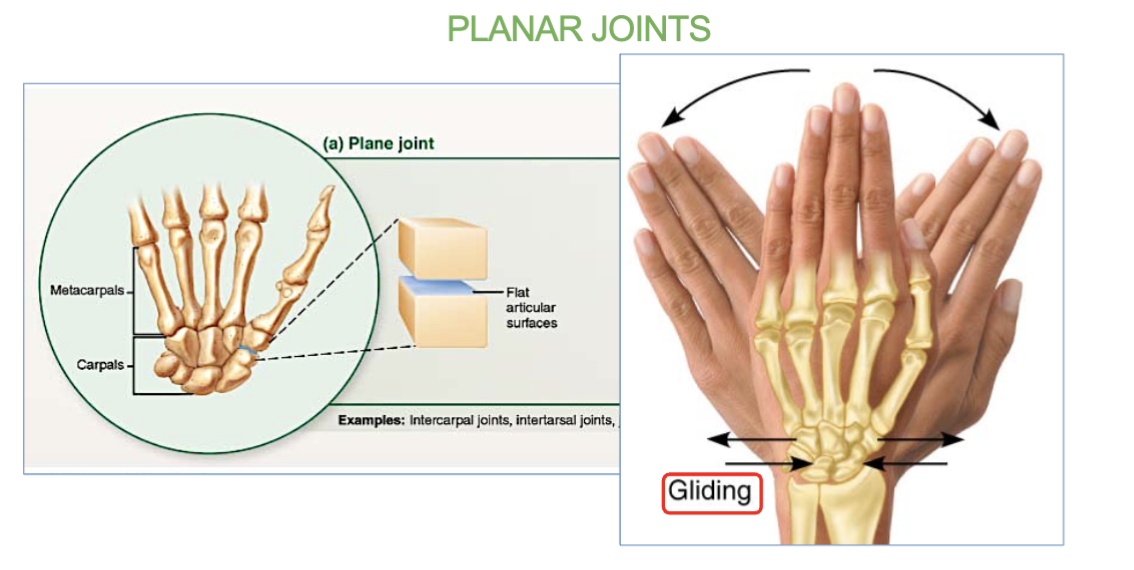
Ball & socket joints definition/job
& 2 examples
allow for multi-axial (360) movement
ex- only the hip and shoulder joints
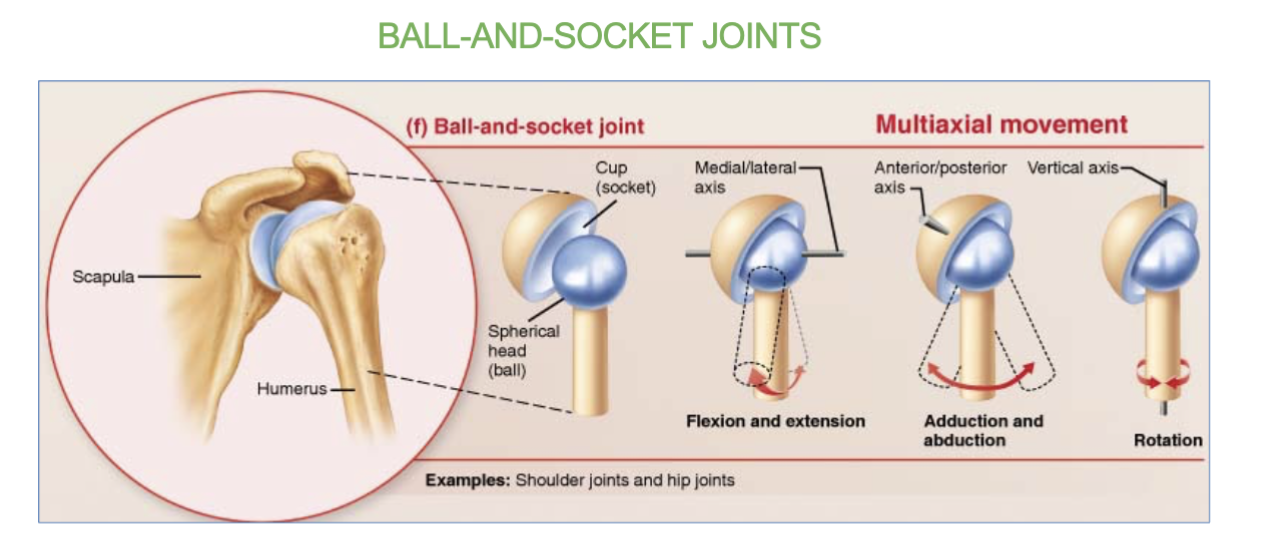
which joints allow for multi-axial (360) movement?
the ball and socket joints.
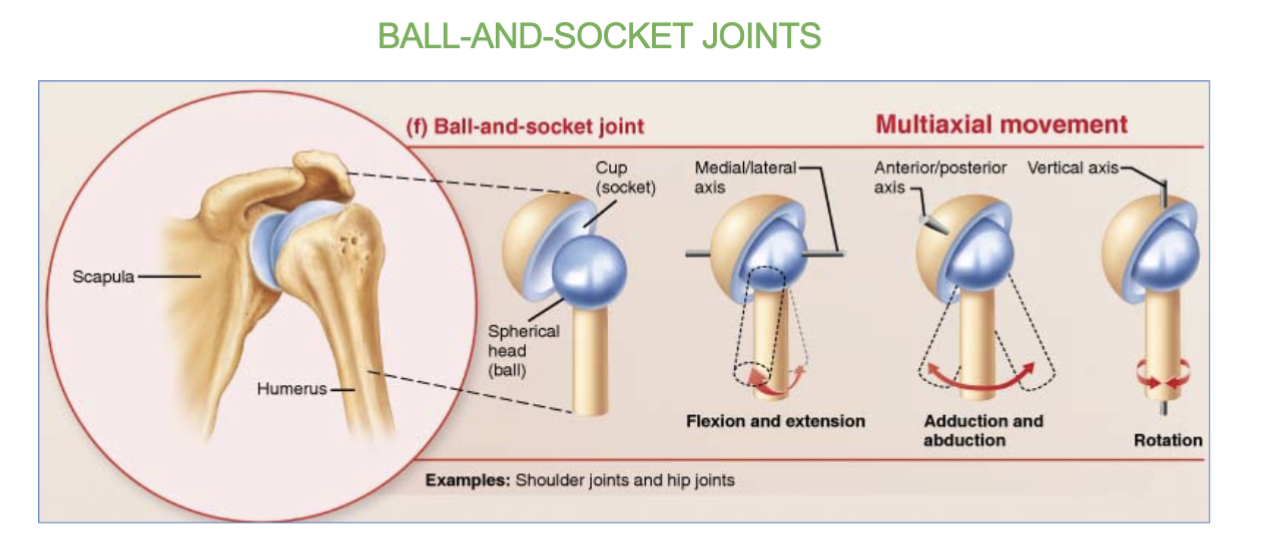
10 Types of Joint movements
flexion & extension (bending up and down)
abduction & adduction (limbs/fingers opening and closing)
depression/elevation (opening/closing mouth and up and down of shoulders)
protraction/retraction (pushing forward/pulling back of chin)
circumduction (circular pattern of limb , 360 degrees)
medial & lateral rotation ( turning head or limbs towards midline or away from midline )
pronation & supination (involves palms facing either posterior or anterior)
Dorsiflexion & Plantar Flexion (toes pointing up or pointing down)
Eversion & Inversion (sole of foot either outward or inward)
thumb opposition (tip of thumb to tip of other fingers)
flexion & extension joint movement
(& hyper extension)
-bending up (being straight) and bending down (90º angle)
(hyper extension is bending back)
-at shoulder, hip, elbow, knee, wrist, and interphalangeal joints
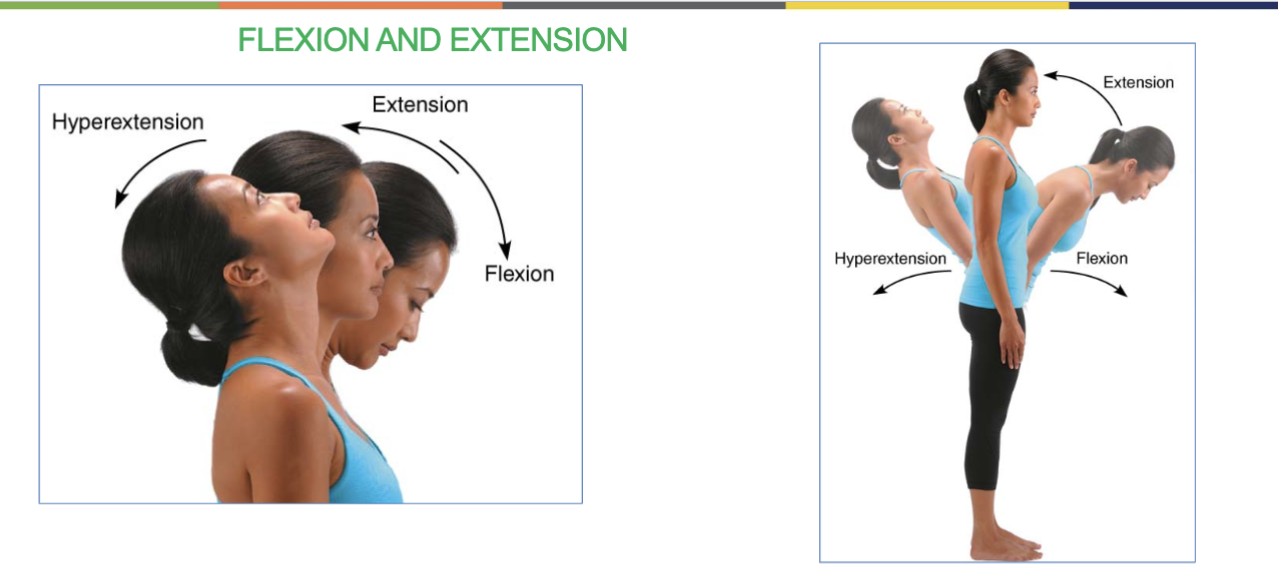
abduction & adduction joint movement
abduction - moving limb/fingers away from body
adduction - moving limb/fingers closer to body
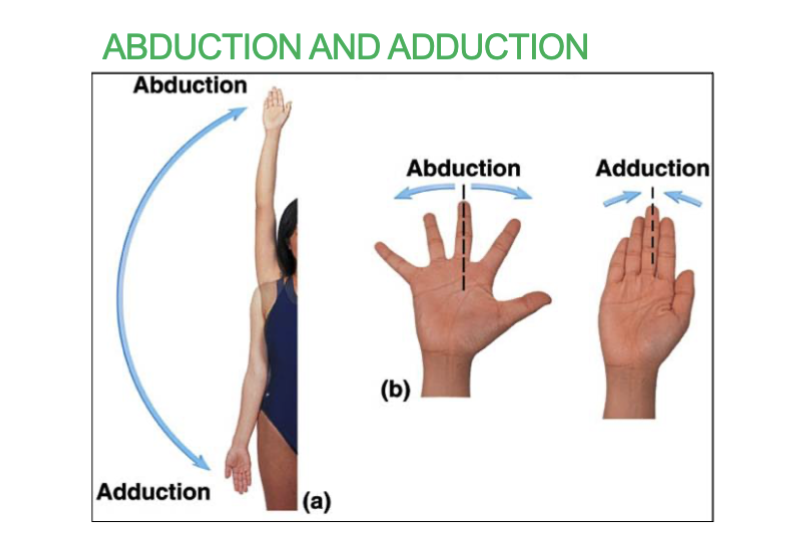
depression/elevation joint movement
depression/elevation - opening/closing mouth and shoulder
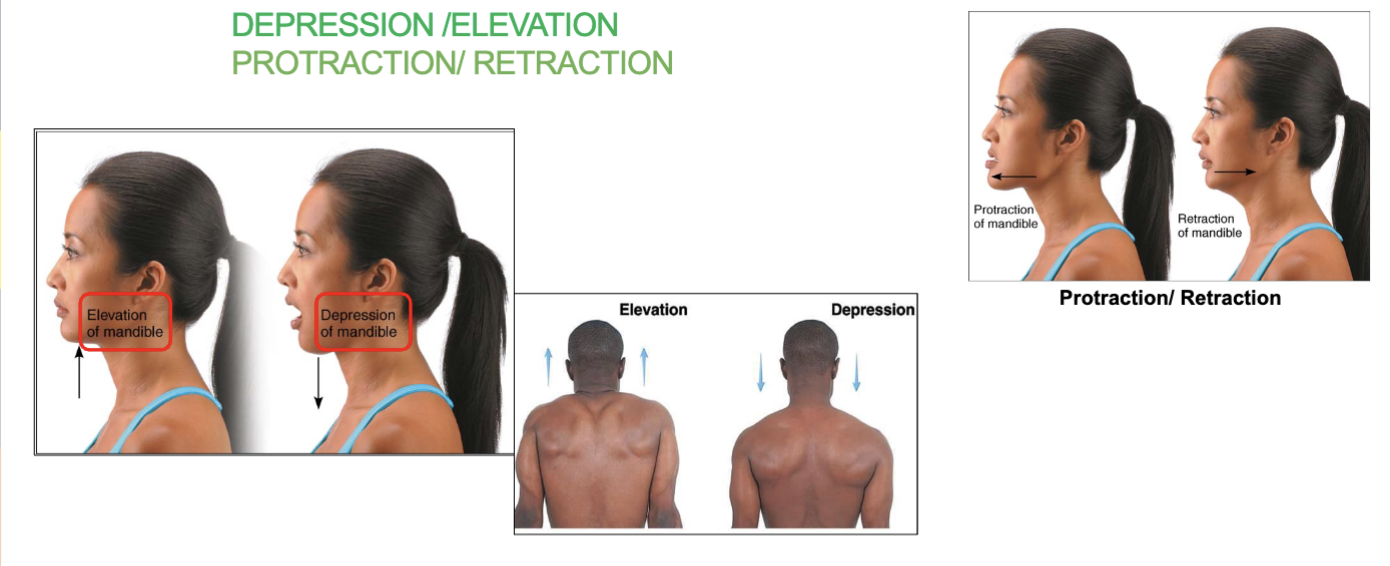
protraction/retraction joint movement
pushing chin forward and pulling chin back
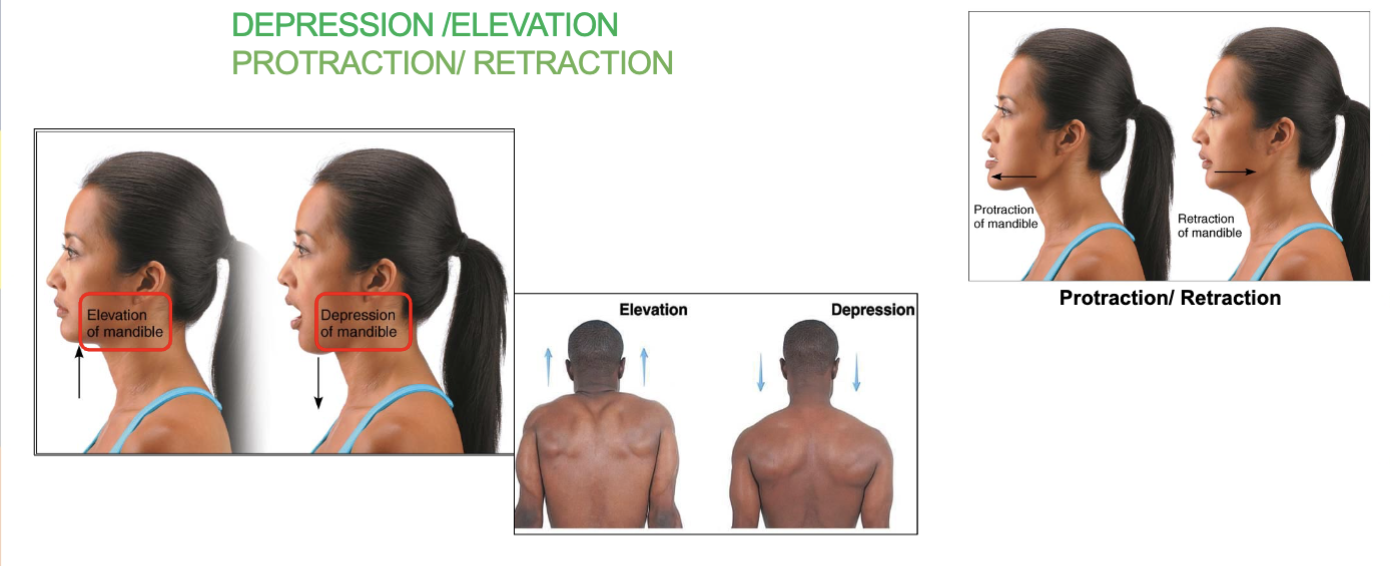
Circumdation joint movement
the movement of the limb in a circular pattern (360 degrees)
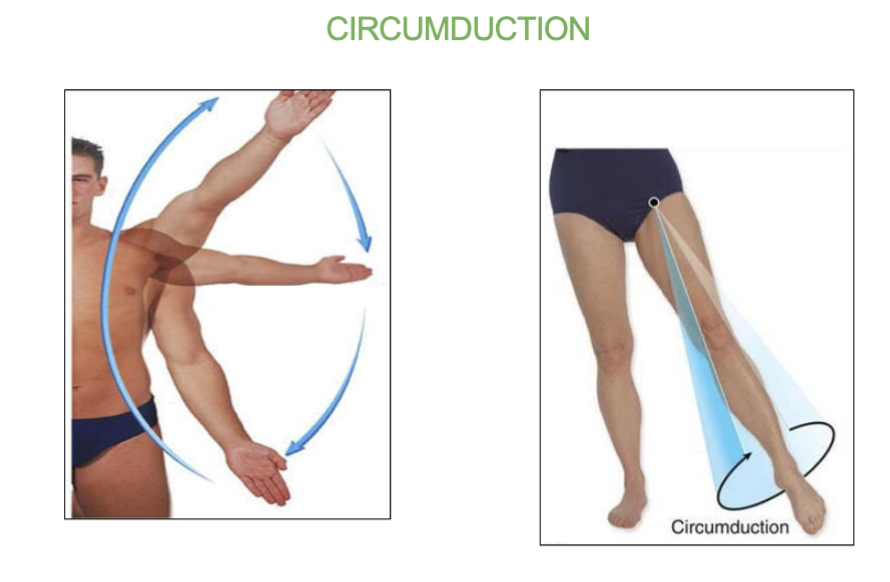
Medial/later rotation joint movement
turning limbs towards midline of body (medial) or away from body (lateral)
- Turning of the head medially or laterally is rotation.
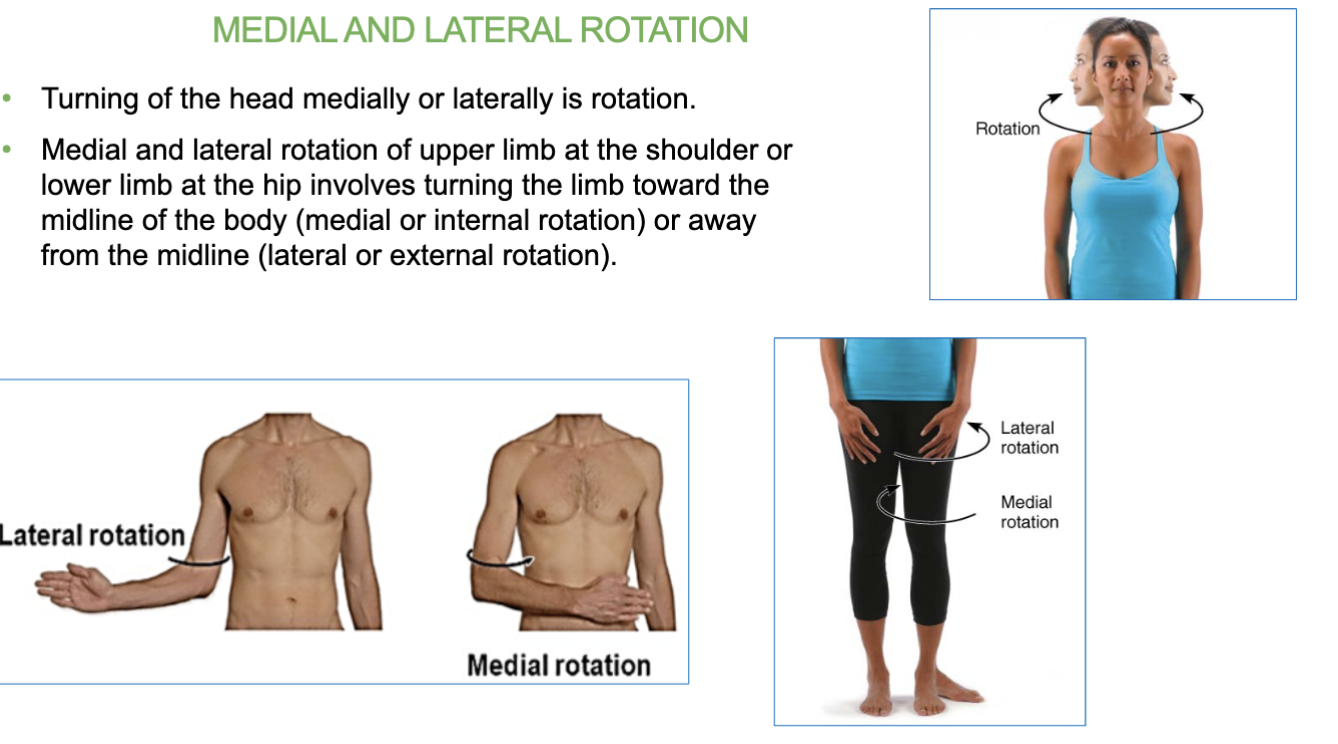
pronation and supination joint movement
forearm pronation/supination involves turning the hands so the palms facing either posterior or anterior
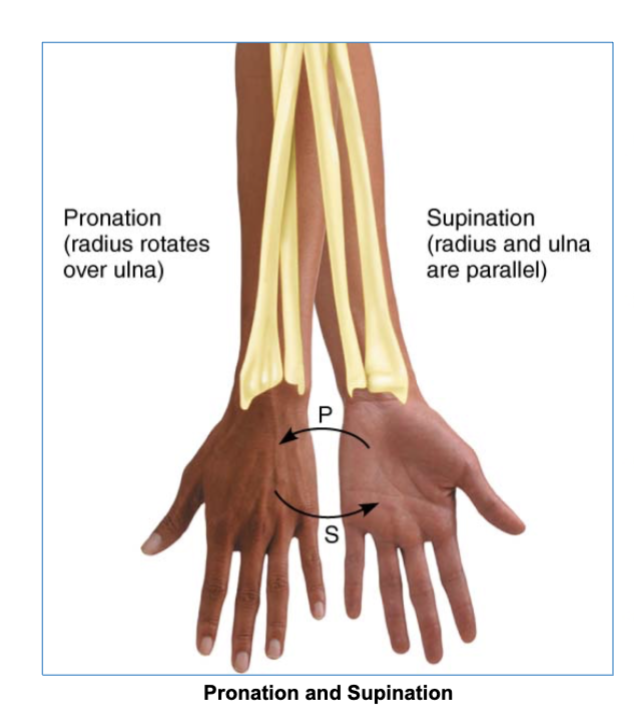
dorsiflexion and plantar flexion (at the ankle) joint movement
makes toes point up or down
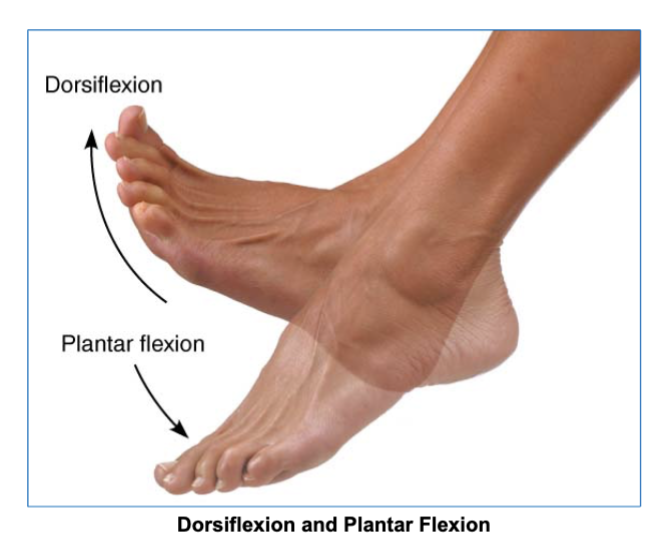
eversion and inversion joint movement
moves the soles of foot either outward or inward
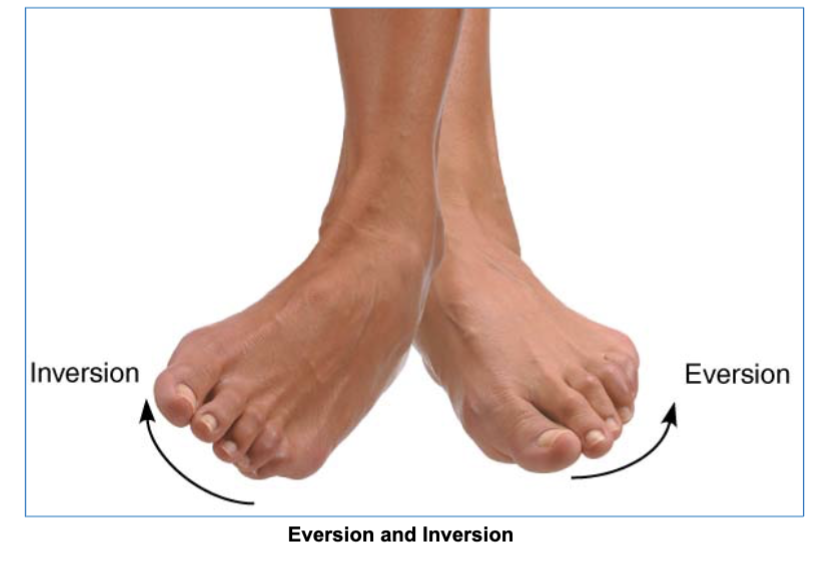
thumb opposition joint movement
brings the tip of thumbs into contact with the other finger tips of the same hand.
